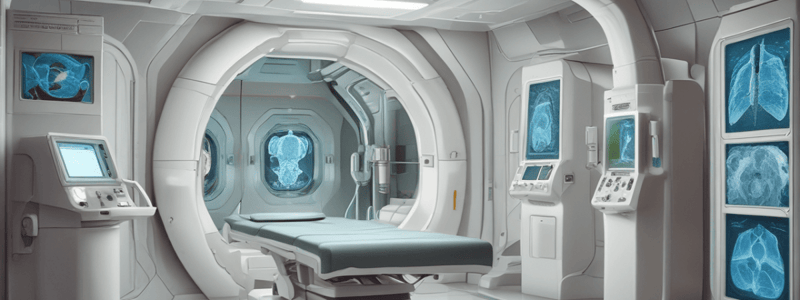Podcast
Questions and Answers
What is a primary principle behind CT scanning technology?
What is a primary principle behind CT scanning technology?
- Ultrasound waves reflect off internal structures.
- Magnetic fields align the nuclei of atoms.
- Infrared light distinguishes between different tissue types.
- Multiple X-ray beams and detectors rotate around the patient. (correct)
Which application of CT is primarily aimed at visualizing tumors and metastases?
Which application of CT is primarily aimed at visualizing tumors and metastases?
- Bone density assessment
- Cross-sectional imaging
- Cancer detection and staging (correct)
- Trauma evaluation
What is one of the major limitations of CT scans?
What is one of the major limitations of CT scans?
- Slower imaging process
- Higher radiation dose (correct)
- Lower image resolution compared to MRI
- Limited to superficial structures
Why might a CT scan be preferred in trauma evaluations?
Why might a CT scan be preferred in trauma evaluations?
What advantage does CT scanning have over traditional X-rays?
What advantage does CT scanning have over traditional X-rays?
Flashcards are hidden until you start studying
Study Notes
Principle and Technology
- Multiple X-ray beams and detectors revolve around the patient to capture data.
- A computer processes the data into detailed cross-sectional images of the body.
Common Applications
- CT scans provide detailed cross-sectional images of internal structures.
- They help detect and stage cancer by visualizing tumors and metastases.
- CT scans are useful for rapid trauma evaluation, assessing injuries quickly and effectively.
Advantages and Limitations
Advantages
- CT scans produce highly detailed images.
- They provide quick results, making them ideal for emergency situations.
- CT scans are excellent for visualizing complex anatomical structures.
Limitations
- CT scans expose patients to a higher radiation dose.
- There is a risk of allergic reactions to contrast materials used in some CT scans.
Studying That Suits You
Use AI to generate personalized quizzes and flashcards to suit your learning preferences.




